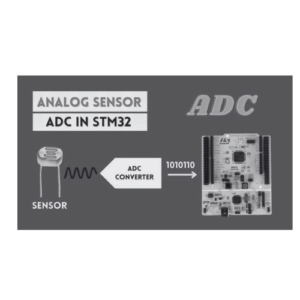Introduction to ARM Cortex-M4 Architecture
The ARM Cortex-M4 is a popular microcontroller architecture designed by ARM Holdings, specifically aimed at embedded applications that require efficient processing, low power consumption, and real-time capabilities. This architecture is widely used in a variety of industries, including automotive, industrial control, consumer electronics, and the Internet of Things (IoT). In this blog post, we will explore the key features, benefits, and typical applications of the ARM Cortex-M4 architecture.
1. Overview of ARM Cortex-M Series
The ARM Cortex-M series consists of several microcontroller cores, each designed to cater to different performance and power requirements:
- Cortex-M0/M0+: Ultra-low-power, entry-level cores for simple applications.
- Cortex-M3: Balanced performance and efficiency, used in general-purpose applications.
- Cortex-M4: Adds digital signal processing (DSP) capabilities and a floating-point unit (FPU) to the Cortex-M3, making it suitable for more complex tasks.
- Cortex-M7: High-performance core with enhanced DSP and FPU capabilities for more demanding applications.
The Cortex-M4 sits in the middle of this series, offering a good balance between performance and power efficiency, with added DSP and floating-point capabilities.
2. Key Features of Cortex-M4
The Cortex-M4 architecture combines the simplicity of a microcontroller with the performance enhancements typically seen in digital signal processors. Here are some of its key features:
- 32-bit Processor: The Cortex-M4 is a 32-bit processor, meaning it can handle 32-bit wide data, providing improved performance over 8-bit and 16-bit architectures.
- Harvard Architecture: It uses a modified Harvard architecture, which separates instruction and data paths, allowing simultaneous instruction fetches and data reads/writes, thus improving throughput.
- Thumb-2 Instruction Set: The processor uses the Thumb-2 instruction set, which combines 16-bit and 32-bit instructions, optimizing code density and performance.
- Digital Signal Processing (DSP) Instructions: The Cortex-M4 includes a set of DSP instructions, such as single-cycle MAC (Multiply-Accumulate) and SIMD (Single Instruction, Multiple Data) instructions, which are beneficial for signal processing tasks.
- Floating-Point Unit (FPU): The Cortex-M4 includes an optional single-precision FPU, which accelerates math-intensive operations like filtering and control algorithms by handling floating-point calculations efficiently.
- Nested Vectored Interrupt Controller (NVIC): The NVIC provides low-latency interrupt handling with automatic context saving, making the Cortex-M4 well-suited for real-time applications.
- Low Power Consumption: Designed for embedded applications, the Cortex-M4 emphasizes power efficiency with several low-power modes and the ability to adjust clock speeds dynamically.
- Memory Protection Unit (MPU): The MPU provides basic memory protection features, enhancing system reliability by preventing certain types of memory access errors.
3. Architecture Overview
The ARM Cortex-M4 core consists of several key components:
- Central Processing Unit (CPU): The CPU executes instructions and manages data flow. It includes general-purpose registers, special registers (e.g., program counter, stack pointer), and a status register.
- Bus Interfaces: The Cortex-M4 includes an AMBA (Advanced Microcontroller Bus Architecture) bus system that connects the CPU with memory and peripherals, enabling efficient data transfers.
- Interrupt System: The NVIC allows for the prioritization and handling of interrupts, critical for real-time applications.
- Debug and Trace Features: The Cortex-M4 includes an embedded trace macrocell (ETM) and other debug features, providing extensive debugging capabilities, which are valuable during the development phase.
4. Benefits of Cortex-M4 Architecture
The Cortex-M4 offers several advantages for embedded systems designers:
- High Performance at Low Power: The combination of efficient instruction execution and low-power modes makes it ideal for battery-powered applications.
- Enhanced Signal Processing Capabilities: The DSP instructions and FPU make it suitable for audio processing, motor control, and other signal processing tasks that require high-speed data manipulation.
- Ease of Development: A large ecosystem of development tools, including IDEs, compilers, and debugging tools, supports the Cortex-M4. Additionally, the ARM community provides extensive resources, examples, and support.
- Scalability: The Cortex-M4 can be scaled up or down within the Cortex-M series, allowing designers to choose a processor that fits their specific performance, power, and cost requirements.
5. Typical Applications
The versatility of the Cortex-M4 makes it suitable for a wide range of applications, including:
- Industrial Automation: Motor control, robotics, and industrial sensors.
- Consumer Electronics: Smart home devices, wearables, and gaming peripherals.
- Automotive: Engine control units, infotainment systems, and ADAS (Advanced Driver Assistance Systems).
- Healthcare: Portable medical devices, fitness trackers, and patient monitoring systems.
- IoT and Smart Devices: Sensor nodes, gateways, and connected devices in IoT networks.
6. Getting Started with Cortex-M4
To start working with Cortex-M4, consider the following steps:
- Choose a Development Board: Numerous development boards, such as the STM32F4 series, NXP Kinetis, and TI Tiva C series, feature Cortex-M4 cores. Select a board that meets your application needs.
- Set Up the Toolchain: Use ARM-supported toolchains like Keil MDK, IAR Embedded Workbench, or open-source options like GCC and the ARM Mbed platform.
- Explore Sample Code and Libraries: Leverage available SDKs and libraries, which often include peripheral drivers, middleware, and application examples to speed up development.
In a nut shell:
The ARM Cortex-M4 architecture is a powerful and versatile choice for embedded system designers, offering a balanced mix of performance, power efficiency, and ease of use. Its advanced DSP capabilities and floating-point support make it particularly well-suited for applications that require real-time data processing and signal manipulation. Whether you are developing for industrial, consumer, automotive, or IoT applications, the Cortex-M4 provides a solid foundation to build upon, supported by a vast ecosystem of tools and community resources.



